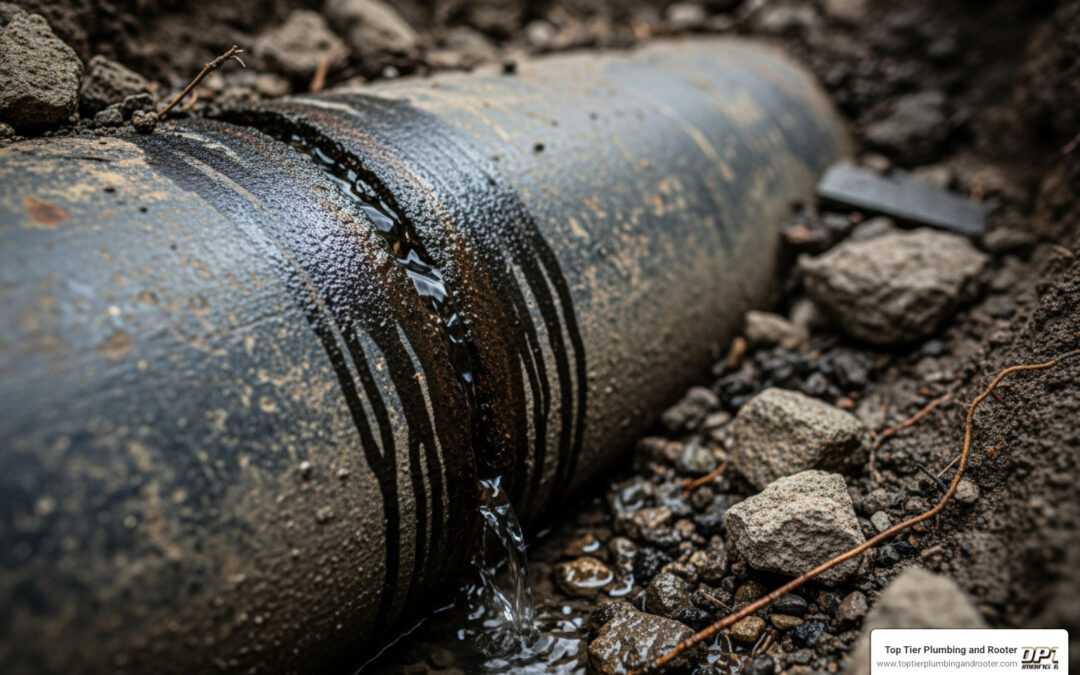Why Sewer Line Health Matters for Your Home
A cracked sewer pipe can silently threaten your home’s foundation, health, and wallet. Understanding the warning signs, causes, and solutions is key to protecting your investment before minor issues become major disasters.
Quick Facts About Cracked Sewer Pipes:
- Common causes: Tree roots, aging materials, ground shifting, and corrosion
- Warning signs: Foul odors, slow drains, soggy lawn patches, and foundation cracks
- Serious consequences: Property damage, health risks, and structural problems
- Modern solutions: Trenchless repair methods minimize disruption to your landscape
- Typical lifespan: Sewer pipes last 75+ years but can fail earlier due to installation errors and environmental factors
Most homeowners rarely think about their sewer system until something goes wrong. These underground pipes work 24/7 to carry waste away, making them one of your property’s most critical systems.
The hidden nature of sewer problems makes early detection crucial. Unlike a visible leak, a cracked sewer pipe can cause damage for months before symptoms appear. By then, you could face expensive repairs to your foundation, landscaping, or home interior.
In Riverside and San Bernardino counties, challenges like expansive clay soils, mature tree roots, and aging infrastructure increase the risk of sewer line problems. Recognizing early warning signs can save you from costly emergency repairs.
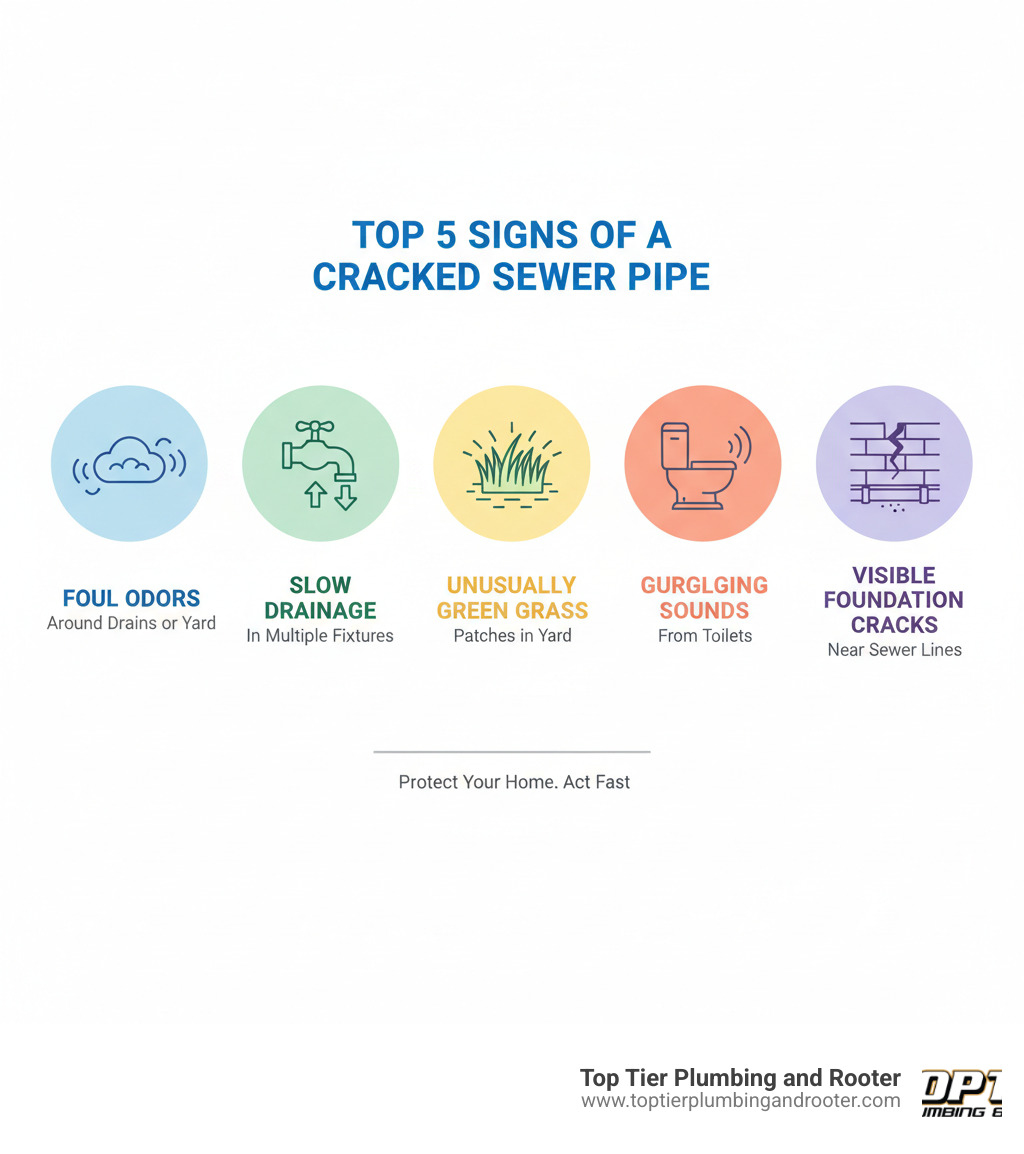
What Causes a Cracked Sewer Pipe?
Understanding what causes sewer pipes to crack helps you spot potential problems before they turn into expensive disasters. While sewer pipes are built to last decades, several factors can cut their lifespan short and leave you dealing with a cracked sewer pipe.
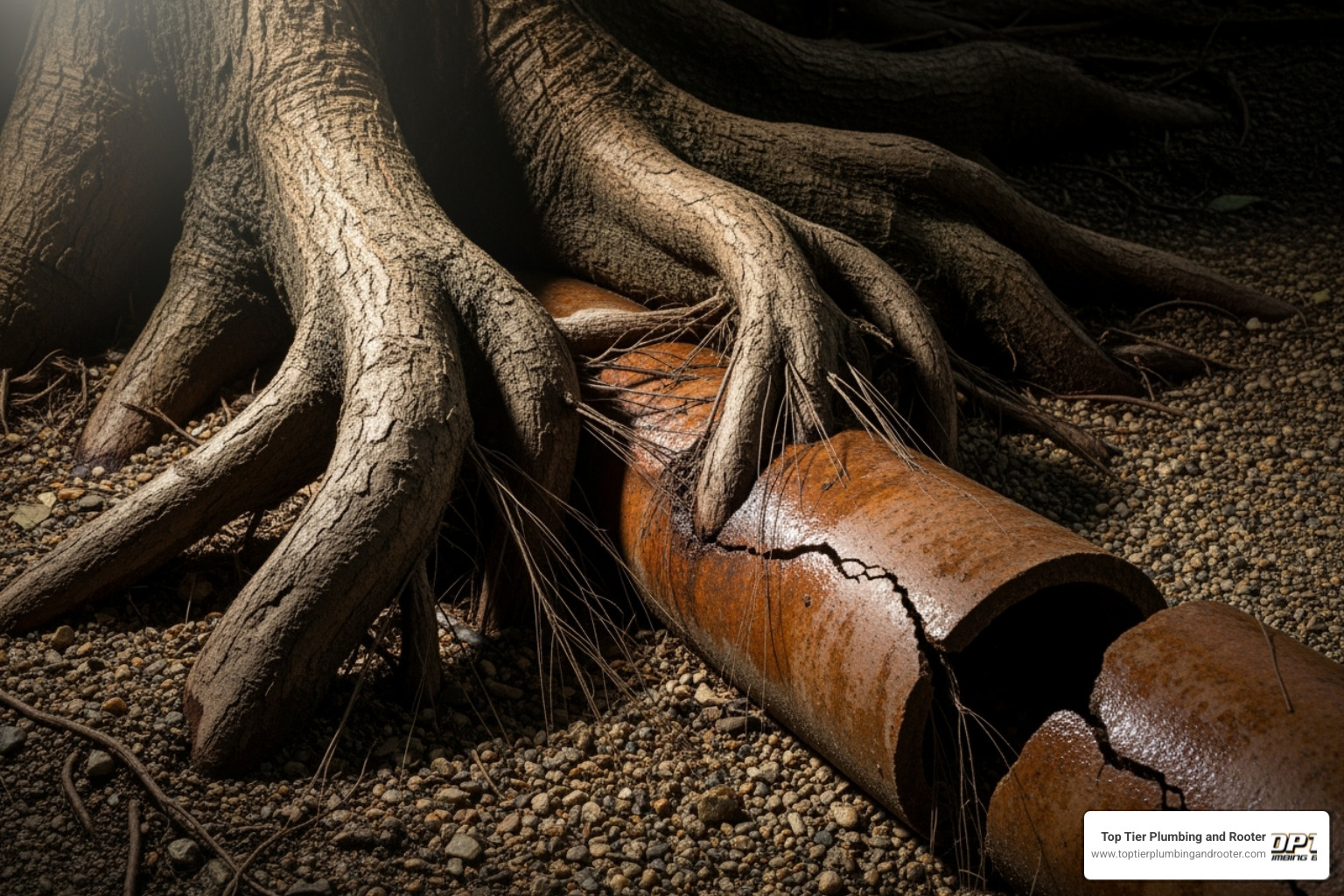
Aging Infrastructure
Many older homes in Riverside and San Bernardino counties have original sewer lines made of clay or cast iron pipes. Over 50 to 75 years, these materials degrade. Clay becomes brittle and cracks, while cast iron rusts from the inside out, leading to weak spots and separated joints.
Pipe Materials Matter
The material your sewer pipe is made from plays a huge role in how long it lasts and what might cause it to crack.
Clay pipes, common in older homes, are vulnerable to cracking from ground movement and tree roots.
Cast iron pipes are strong but prone to internal corrosion from wastewater. Over time, this rust creates pits that develop into holes and cracks.
PVC pipes are a modern, rust-proof material that resists roots and handles ground movement well. However, improper installation or extreme pressure can still cause cracks.
When the Ground Gets Restless
Shifting soil, especially expansive clay soil, puts significant stress on underground pipes. This ground movement, caused by moisture changes, earthquakes, or nearby construction, can bend and eventually break pipes.
Tree Roots: Nature’s Pipe Wreckers
Tree root infiltration is a primary cause of sewer pipe damage. Roots are drawn to moisture from small leaks, entering the pipe and expanding. This process widens cracks, creates blockages, and can eventually break the pipe. Roots can travel long distances, so even a neighbor’s tree could be the source of the problem. Our guide on Plumbing Under Siege: Defending Your Pipes from Invasive Roots in Riverside and San Bernardino County explains how to protect your pipes from these underground invaders.
Installation Problems That Come Back to Haunt You
Sometimes a cracked sewer pipe is the result of improper installation. Pipes installed at the wrong slope won’t drain properly, leading to backups and pressure buildup. Poor joint connections create leak points where roots can enter, and inadequate bedding material around pipes leaves them unsupported when the ground shifts.
Pressure and Temperature Take Their Toll
High water pressure can stress your sewer system over time, turning small cracks into big problems. Extreme temperature changes also play a role, as the expansion and contraction over many years can weaken pipe materials and joints.
Understanding these causes helps you take steps to protect your sewer system and catch problems early, before they turn into major headaches.
Telltale Signs: How to Spot a Sewer Line Problem
A cracked sewer pipe might be hiding underground, but your home has ways of telling you when something’s wrong. The sooner you listen, the better.
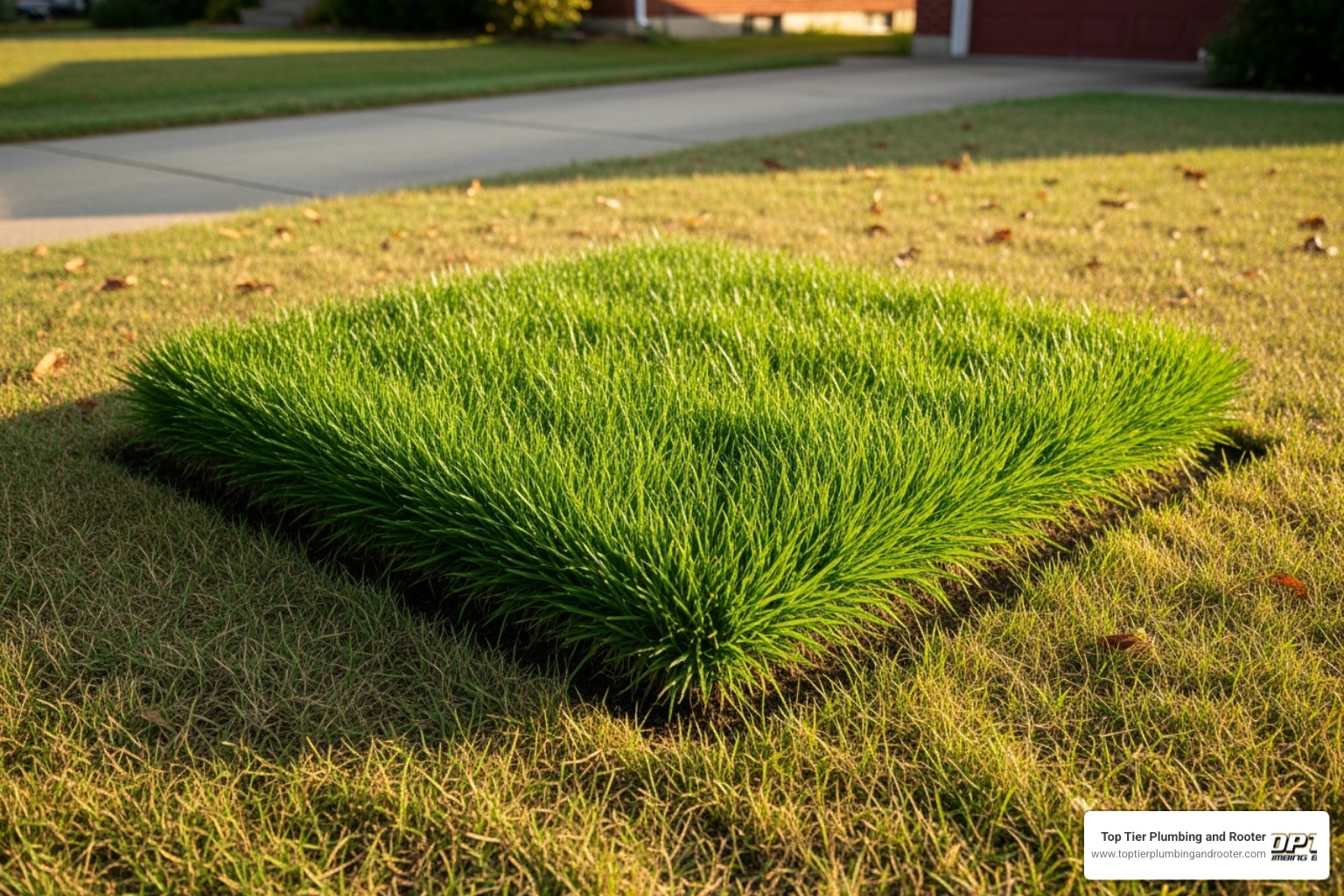
A primary clue is foul odors of sewer gas near drains, in the basement, or in your yard. This indicates your sewer line is no longer sealed. These gases are not just unpleasant; they can cause health issues like headaches and dizziness.
While a single slow drain may be a simple clog, slow drainage in multiple fixtures points to a main sewer line issue. This is often accompanied by frequent clogs that recur despite being cleared.
Gurgling sounds from the toilet after flushing or fluctuating water levels indicate trapped air from a blockage. Water backing up into a shower or tub when another fixture is used is another clear sign of a main line problem.
Inspect your yard for a soggy lawn or unusually lush, green patches of grass. Leaking sewage fertilizes the soil, creating these spots. Standing water when it hasn’t rained is another indicator of an underground leak.
More serious signs include foundation cracks or small sinkholes in your yard. When a cracked sewer pipe leaks continuously, it erodes the surrounding soil, which can compromise your home’s foundation over time.
An increase in rodent problems and insect infestations, especially sewer flies and cockroaches, can also occur when there’s a break in your sewer line, giving them a convenient entry point into your home.
For immediate concerns about sewage issues, check out our guide on Sewer Clearing Emergency: How to Identify and Address Urgent Sewage Issues.
Warning Signs to Watch For
Keep an eye out for these key indicators that suggest your sewer line needs professional attention:
- Persistent sewer gas odors around drains or in your yard
- Multiple slow-draining fixtures throughout your home
- Frequent clogs or backups in various drains
- Gurgling sounds from toilets or other fixtures
- Unusually green or soggy patches in your lawn
- Foundation cracks or small depressions in your yard
- Increased pest activity, especially rodents and insects
- Wet spots on walls or floors accompanied by foul smells
The key is paying attention to patterns. One isolated incident might not mean much, but multiple signs appearing together almost certainly indicate a sewer line problem that needs professional diagnosis.
The Consequences of Ignoring Sewer Line Damage
Ignoring a cracked sewer pipe allows a small problem to escalate into a costly nightmare affecting your health, home, and finances. The longer you wait, the more extensive the damage becomes.
Property Damage Starts Small But Grows Fast
Leaking sewage leads to significant water damage as it seeps into your foundation, floors, and basement, ruining belongings and structural components. This moisture also creates a perfect environment for mold growth, which can spread rapidly through walls and insulation, requiring costly remediation.
Health Risks That Affect Your Whole Family
A cracked sewer pipe poses serious health risks. Sewer gas leaks can release toxic compounds like methane and hydrogen sulfide into your home, causing headaches, dizziness, and respiratory issues. Furthermore, raw sewage contaminates the ground with harmful bacteria and viruses, creating soil pollution that is hazardous for children and pets and can even affect local groundwater.
Structural Damage That Threatens Your Home’s Foundation
Long-term leaks saturate the ground, causing soil erosion that can lead to serious foundation problems. As the soil weakens, your foundation can shift or settle, resulting in wall cracks, uneven floors, and doors that stick. In severe cases, this erosion can create dangerous sinkholes in your yard.
An Open Invitation for Unwanted Guests
A compromised sewer line becomes a highway for pest infestations. Rodents, cockroaches, and sewer flies can squeeze through small cracks to enter your home, bringing their own health risks and property damage.
The reality is that ignoring a suspected cracked sewer pipe is a gamble. The initial investment in professional inspection and repair will always be less than the potential costs of extensive property damage, health complications, and structural repairs down the road.
For a comprehensive look at why prompt action matters, check out our detailed guide on The Hidden Dangers of Ignoring Drainage Issues: What Homeowners Need to Know. Understanding how plumbing systems have evolved can also provide valuable context – you can learn more about plumbing history and materials to see how modern solutions address these age-old problems.
Diagnosis and Repair: Modern Solutions for Sewer Pipe Damage
If you suspect a cracked sewer pipe, modern plumbing technology offers precise diagnostic tools and repair methods. These solutions can pinpoint and fix problems with minimal disruption, avoiding the need for massive excavation.
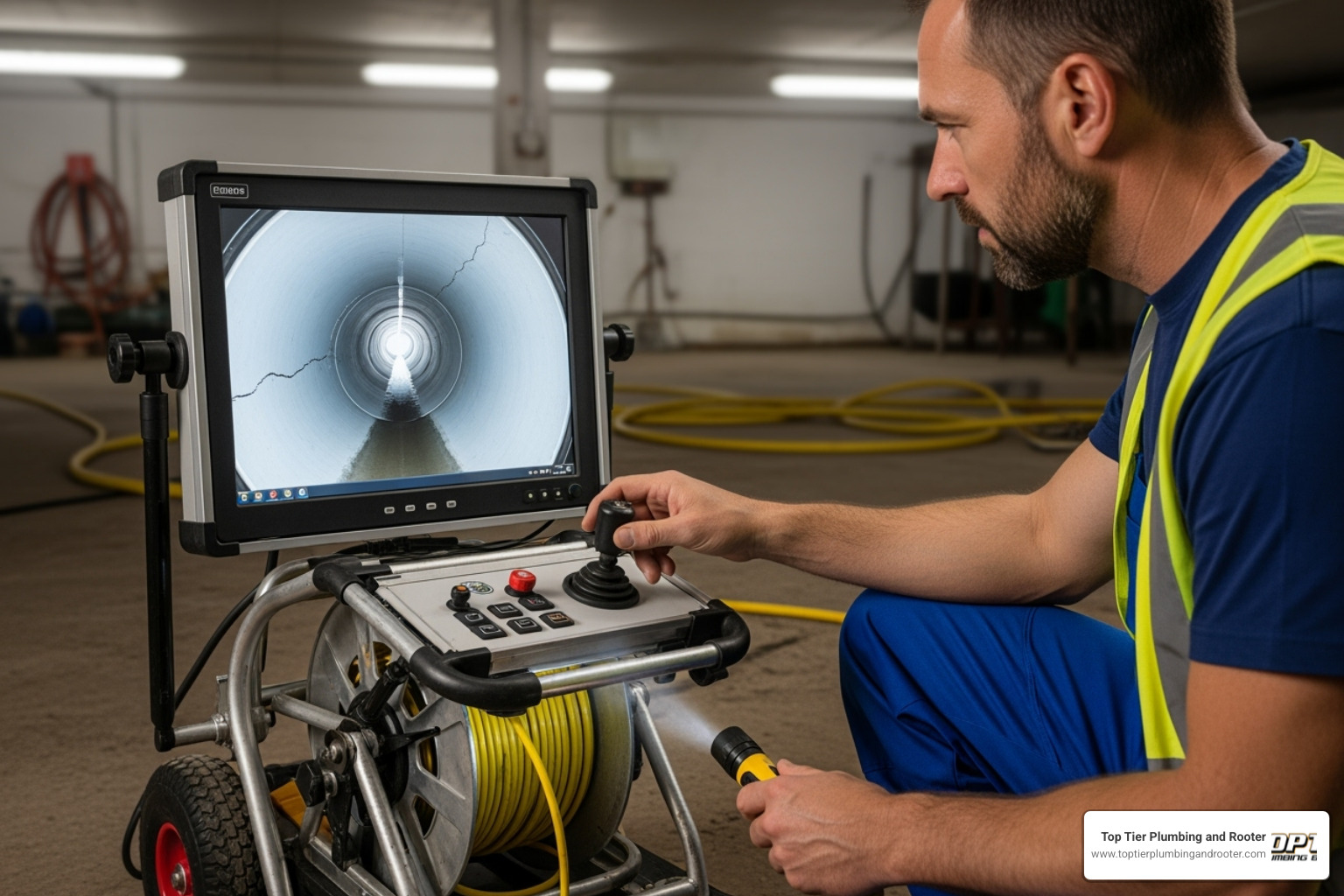
How Professionals Diagnose a Cracked Sewer Pipe
The first step is a thorough professional inspection. The most effective diagnostic tool is a video camera inspection. A high-resolution, waterproof camera on a flexible cable is inserted into the sewer line. It provides a real-time view of the pipe’s interior, allowing technicians to identify the exact location and nature of any damage, such as cracks, root intrusion, corrosion, or blockages. This method ensures an accurate diagnosis and allows for targeted repairs. To learn more about this innovative approach, check out The Role of Video Inspection in Sewer and Drain Repair.
In some cases, smoke testing is used to find hard-to-locate leaks. Non-toxic smoke is introduced into the line, and if it escapes, it becomes visible above ground, pinpointing the problem spot.
Hydrostatic testing can also be used. A section of pipe is sealed and filled with pressurized water. A drop in pressure indicates a leak in that section, helping to confirm and narrow down the problem area.
Traditional vs. Trenchless Repair Methods
Once a cracked sewer pipe is identified, it’s time for repair. Traditional excavation, or the “dig-and-replace” method, involves digging a trench to remove and replace the damaged pipe. While sometimes necessary for a collapsed pipe, it is highly disruptive to your property.
Trenchless technology has revolutionized sewer repair. This approach allows us to fix or replace sewer lines with minimal disruption by using only one or two small access points. This preserves your landscaping and driveway, saving you from extensive restoration work. Trenchless methods are faster and less invasive than traditional options. For a deeper dive into why this approach makes so much sense, read about The Benefits of Trenchless Sewer Repair for Your Home or Business.
Understanding Your Options: Pipe Lining vs. Pipe Bursting
Within trenchless technology, two primary methods for fixing a cracked sewer pipe are pipe lining and pipe bursting.
Pipe lining, or Cured-in-Place Pipe (CIPP), creates a new pipe inside the old one. A flexible, resin-saturated liner is inserted into the damaged pipe and inflated. The epoxy resin then cures, forming a hard, durable, and seamless new pipe. This new pipe installation is corrosion-resistant and prevents future root intrusion, often making it stronger than the original pipe.
Pipe bursting is used when the original pipe is too damaged to be lined. This technique pulls a new, high-density polyethylene pipe through the old one. A bursting head fractures the old pipe outward into the surrounding soil while pulling the new pipe into place.
Here’s a helpful comparison of these two methods:
| Feature | Pipe Lining (CIPP) | Pipe Bursting |
|---|---|---|
| Method | Resin-soaked tube inserted and cured inside existing pipe | New pipe pulled through old pipe, fragmenting it simultaneously |
| Best Use Cases | Cracked, corroded, or root-infested pipes that still have structural integrity | Severely damaged, collapsed, or undersized pipes needing complete replacement |
| Outcome | Creates a brand-new, seamless pipe within the existing pipe | Installs a completely new pipe, often with larger diameter |
Both methods offer long-lasting, durable solutions that will keep your sewer system running smoothly for decades to come without destroying your yard.
Frequently Asked Questions about Sewer Pipes
When dealing with a cracked sewer pipe, homeowners naturally have plenty of questions. Here are clear, honest answers to help you make informed decisions.
How long do sewer pipes typically last?
Sewer pipes are built to last, typically 75 years or more, but several factors can shorten this lifespan.
- Pipe Material: Older cast iron pipes corrode over time, while clay pipes become brittle and crack. Modern PVC pipes are more resilient to corrosion and root intrusion.
- Installation Quality: Poor installation, such as incorrect grading or weak joint connections, creates vulnerabilities that lead to premature failure.
- Soil Conditions: In Riverside and San Bernardino counties, expansive clay soils shift and stress pipes. Acidic soils can also accelerate corrosion.
- Tree Roots: Nearby tree roots seek moisture from tiny pipe cracks, eventually growing inside and breaking the pipe.
- Usage: Flushing grease, harsh chemicals, or non-biodegradable items can cause blockages and damage that shorten a pipe’s life.
We often see problems in pipes that are only 40 to 50 years old. If you’re wondering about your home’s plumbing timeline, check out our guide on When Should Plumbing Pipes Be Replaced?
Does homeowners insurance cover sewer pipe repair?
The answer to this question is often complex. Most standard homeowners insurance policies do not cover sewer line repairs caused by common issues like wear and tear, aging, corrosion, ground movement, or tree root intrusion. These are typically considered maintenance issues.
However, many providers offer special endorsements or riders for service line or water backup coverage. Sudden and accidental damage, such as a line being damaged during excavation, might be covered by a standard policy.
Our advice is to call your insurance agent to confirm your specific coverage and inquire about available endorsements. A small additional premium can provide valuable protection.
For a deeper dive into this topic, read our detailed guide on How Plumbing Insurance Relates to Your Pipes. You can also find general plumbing advice at Plbg.com.
What should I do if I suspect a cracked sewer pipe?
If you suspect a cracked sewer pipe, act quickly to prevent the problem from worsening.
- Stop using water immediately if you have active sewage backups into your home. This prevents more sewage from entering.
- Avoid chemical drain cleaners. These harsh chemicals can damage pipes and create hazardous conditions for plumbers.
- Document the signs. Take photos or videos of soggy lawn patches, backups, or foundation cracks. Note any foul odors, gurgling sounds, or slow drains.
- Call a professional plumber immediately. A cracked sewer pipe is not a DIY project and requires specialized equipment and expertise. Our team at Top Tier Plumbing and Rooter offers 24/7 same-day service in Riverside and San Bernardino counties to address these urgent issues.
The sooner you act, the better your chances of preventing extensive property damage. For more guidance on handling plumbing emergencies, check out Emergency Plumbing 101: What Every Homeowner in California Should Know.
Protect Your Property with Professional Sewer Services
Protecting your home from a cracked sewer pipe is crucial. As we’ve discussed, these hidden threats can cause extensive damage before you’re even aware of them.
Proactive maintenance is the key. Regular inspections offer significant early detection benefits, saving you from sewage backups, costly foundation damage, and family health risks. Catching a problem early often means you can use less invasive and more affordable trenchless repair methods, preserving your yard.
In Riverside and San Bernardino counties, unique challenges like expansive clay soils and mature trees make professional expertise essential. At Top Tier Plumbing and Rooter, we use advanced technology like video camera inspections to provide accurate diagnoses, not guesswork. We deliver honest assessments and effective repairs done right the first time.
When facing a potential cracked sewer pipe, you need a team that understands the urgency. We are available 24/7 and provide same-day service because we know these problems can’t wait. We guarantee our work and explain everything clearly, ensuring your peace of mind.
Don’t let a small crack become a major disaster. Schedule your professional drain and sewer service today and let our team protect your home and family.


